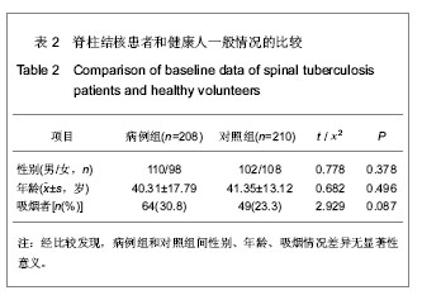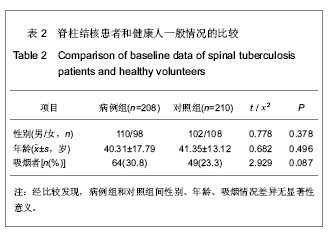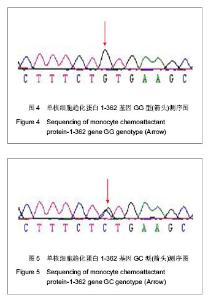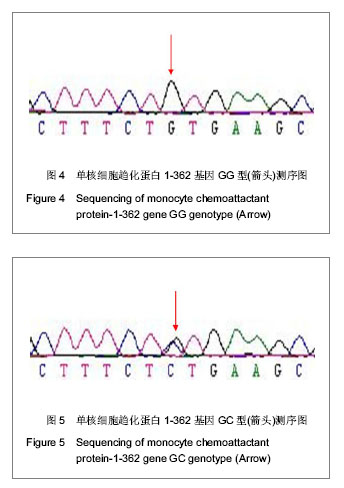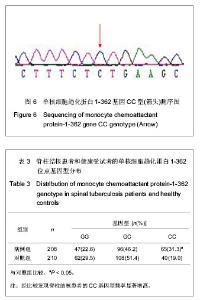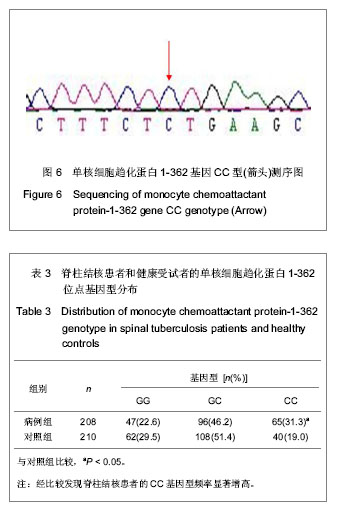Chinese Journal of Tissue Engineering Research ›› 2013, Vol. 17 ›› Issue (30): 5503-5510.doi: 10.3969/j.issn.2095-4344.2013.30.014
Previous Articles Next Articles
Serum monocyte chemoattactant protein-1 level and spinal tuberculosis susceptibility
Guo Chao-feng, Zhang Hong-qi, Gao Qi-le, Tang Ming-xing, Liu Shao-hua, Deng Ang, Wang Yu-xiang, Lu Shi-jin, Li Jin-song, Yin Xin-hua
- Department of Spinal Surgery, Xiangya Hospital of Central South University, Xiangya Spinal Surgery Center, Changsha 410008, Hunan Province, China
-
Received:2013-01-10Revised:2013-06-01Online:2013-07-23Published:2013-07-23 -
Contact:Zhang Hong-qi, Professor, Doctoral supervisor, Chief physician, Department of Spinal Surgery, Xiangya Hospital of Central South University, Xiangya Spinal Surgery Center, Changsha 410008, Hunan Province, China zhq9996@ yahoo.com.cn -
About author:Guo Chao-feng☆, M.D., Attending physician, Department of Spinal Surgery, Xiangya Hospital of Central South University, Xiangya Spinal Surgery Center, Changsha 410008, Hunan Province, China 343942471@qq.com -
Supported by:Fundamental Research Funds for the Central Universities, No. 2012QNZT101
CLC Number:
Cite this article
Guo Chao-feng, Zhang Hong-qi, Gao Qi-le, Tang Ming-xing, Liu Shao-hua, Deng Ang, Wang Yu-xiang, Lu Shi-jin, Li Jin-song, Yin Xin-hua. Serum monocyte chemoattactant protein-1 level and spinal tuberculosis susceptibility[J]. Chinese Journal of Tissue Engineering Research, 2013, 17(30): 5503-5510.
share this article
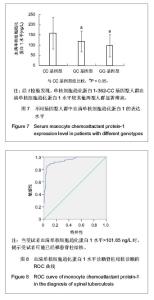
2.4 不同人群中血清单核细胞趋化蛋白1的表达水平 酶联免疫吸附试验结果显示,脊柱结核患者血清单核细胞趋化蛋白1水平显著高于健康人群[(134.58±51.63) ng/L vs. (39.18±17.45) ng/L,t=-4.38,P < 0.05];男性受试者与女性受试者间血清单核细胞趋化蛋白1水平差异无显著性意义[(84.13±35.22) ng/L vs. (79.87± 40.66) ng/L,t=-0.532,P > 0.05]。 2.5 不同基因型受试者血清单核细胞趋化蛋白1的水平 单因素方差分析结果显示:不同单核细胞趋化蛋白1-362基因型人群血清单核细胞趋化蛋白1水平差异有显著性意义(F=5.225,P=0.008)。其中CC基因型人群血清单核细胞趋化蛋白1水平显著高于GC基因型人群(t=2.191,P=0.032)和GG基因型人群(t=3.161,P= 0.002),但GC基因型人群和GG基因型人群之间血清单核细胞趋化蛋白1水平差异无显著性意义(t=1.158,P= 0.252),见图7。 2.6 血清单核细胞趋化蛋白1水平对脊柱结核的诊断性检验 实验采用ROC曲线法对血清单核细胞趋化蛋白1水平进行诊断性检验。结果显示ROC曲线下面积为0.946(95%可信区间:0.916-0.975,P < 0.001),诊断阈值为101.65 ng/L,即当受试者血清单核细胞趋化蛋白1水平>101.65 ng/L时,提示受试者可能已经罹患脊柱结核(敏感度:85.5%,特异度:94.3%,约登指数:0.799),见图8。"
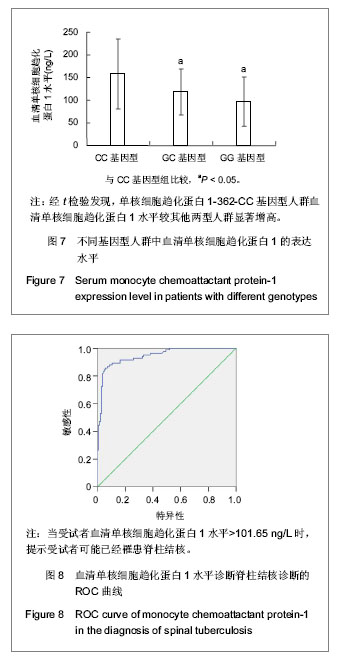
| [1] Ramsay A, Steingart KR, Cunningham J, et al. Translating tuberculosis research into global policies: the example of an international collaboration on diagnostics. Int J Tuberc Lung Dis. 2011;15(10):1283-1293. [2] Schirmer P, Renault CA, Holodniy M. Is spinal tuberculosis contagious? Int J Infect Dis. 2010;14(8):e659-666. [3] Philips JA, Ernst JD. Tuberculosis pathogenesis and immunity. Annu Rev Pathol. 2012;7:353-384. [4] Zárate-Bladés CR, Rodrigues RF, Souza PR, et al. Evaluation of the overall IFN-γ and IL-17 pro-inflammatory responses after DNA therapy of tuberculosis. Hum Vaccin Immunother. In press.[5] Raja A. Immunology of tuberculosis. Indian J Med Res. 2004; 120(4):213-232.[6] Jo EK, Park JK, Dockrell HM. Dynamics of cytokine generation in patients with active pulmonary tuberculosis. Curr Opin Infect Dis. 2003;16(3):205-210.[7] Thye T, Nejentsev S, Intemann CD, et al. MCP-1 promoter variant -362C associated with protection from pulmonary tuberculosis in Ghana, West Africa. Hum Mol Genet. 2009; 18(2):381-388.[8] 张宏其,高琪乐,郭超峰,等.单核细胞趋化蛋白-1基因多态性对脊柱结核易感性的影响[J].中国矫形外科杂志,2012,20(9):843- 846.[9] Scott HM, Flynn JL. Mycobacterium tuberculosis in chemokine receptor 2-deficient mice: influence of dose on disease progression. Infect Immun. 2002;70(11):5946-5954.[10] Saukkonen JJ, Bazydlo B, Thomas M, et al. Beta-chemokines are induced by Mycobacterium tuberculosis and inhibit its growth. Infect Immun. 2002;70(4):1684-1693.[11] Peters W, Scott HM, Chambers HF, et al. Chemokine receptor 2 serves an early and essential role in resistance to Mycobacterium tuberculosis. Proc Natl Acad Sci U S A. 2001; 98(14):7958-7963. [12] Arias MA, Pantoja AE, Jaramillo G, et al. Chemokine receptor expression and modulation by Mycobacterium tuberculosis antigens on mononuclear cells from human lymphoid tissues. Immunology. 2006;118(2):171-184. [13] Flores-Villanueva PO, Ruiz-Morales JA, Song CH, et al. A functional promoter polymorphism in monocyte chemoattractant protein-1 is associated with increased susceptibility to pulmonary tuberculosis. J Exp Med. 2005;202(12):1649-1658.[14] Buijtels PC, van de Sande WW, Parkinson S, et al. Polymorphism in CC-chemokine ligand 2 associated with tuberculosis in Zambia. Int J Tuberc Lung Dis. 2008;12(12): 1485-1488.[15] Deshmane SL, Kremlev S, Amini S, et al. Monocyte chemoattractant protein-1 (MCP-1): an overview. J Interferon Cytokine Res. 2009;29(6):313-326. [16] Ajuebor MN, Flower RJ, Hannon R, et al. Endogenous monocyte chemoattractant protein-1 recruits monocytes in the zymosan peritonitis model. J Leukoc Biol. 1998;63(1): 108-116. [17] Palframan RT, Jung S, Cheng G, et al. Inflammatory chemokine transport and presentation in HEV: a remote control mechanism for monocyte recruitment to lymph nodes in inflamed tissues. J Exp Med. 2001;194(9): 1361-1373.[18] Nio Y, Yamauchi T, Iwabu M, et al. Monocyte chemoattractant protein-1 (MCP-1) deficiency enhances alternatively activated M2 macrophages and ameliorates insulin resistance and fatty liver in lipoatrophic diabetic A-ZIP transgenic mice. Diabetologia. 2012;55(12):3350-3358.[19] Daly C, Rollins BJ. Monocyte chemoattractant protein-1 (CCL2) in inflammatory disease and adaptive immunity: therapeutic opportunities and controversies. Microcirculation. 2003;10(3-4):247-257.[20] Gu L, Rutledge B, Fiorillo J, et al. In vivo properties of monocyte chemoattractant protein-1. J Leukoc Biol. 1997;62(5):577-580.[21] Dawson J, Miltz W, Mir AK, et al. Targeting monocyte chemoattractant protein-1 signalling in disease. Expert Opin Ther Targets. 2003;7(1):35-48. [22] Conductier G, Blondeau N, Guyon A, et al. The role of monocyte chemoattractant protein MCP1/CCL2 in neuroinflammatory diseases. J Neuroimmunol. 2010;224 (1-2):93-100.[23] Salem ML, El-Naggar SA, Kadima A, et al. The adjuvant effects of the toll-like receptor 3 ligand polyinosinic-cytidylic acid poly (I:C) on antigen-specific CD8+ T cell responses are partially dependent on NK cells with the induction of a beneficial cytokine milieu. Vaccine. 2006;24(24):5119- 5132. [24] Cushing SD, Berliner JA, Valente AJ, et al. Minimally modified low density lipoprotein induces monocyte chemotactic protein 1 in human endothelial cells and smooth muscle cells. Proc Natl Acad Sci U S A. 1990;87(13):5134-5138.[25] Standiford TJ, Kunkel SL, Phan SH, et al. Alveolar macrophage-derived cytokines induce monocyte chemoattractant protein-1 expression from human pulmonary type II-like epithelial cells. J Biol Chem. 1991;266(15): 9912-9918.[26] Brown Z, Strieter RM, Neild GH, et al. IL-1 receptor antagonist inhibits monocyte chemotactic peptide 1 generation by human mesangial cells. Kidney Int. 1992;42(1):95-101.[27] Barna BP, Pettay J, Barnett GH, et al. Regulation of monocyte chemoattractant protein-1 expression in adult human non-neoplastic astrocytes is sensitive to tumor necrosis factor (TNF) or antibody to the 55-kDa TNF receptor. J Neuroimmunol. 1994;50(1):101-107.[28] Algood HM, Chan J, Flynn JL. Chemokines and tuberculosis. Cytokine Growth Factor Rev. 2003;14(6):467-477. [29] Rovin BH, Lu L, Saxena R. A novel polymorphism in the MCP-1 gene regulatory region that influences MCP-1 expression. Biochem Biophys Res Commun. 1999;259(2):344-348. [30] Matsukawa A, Lukacs NW, Standiford TJ, et al. Adenoviral-mediated overexpression of monocyte chemoattractant protein-1 differentially alters the development of Th1 and Th2 type responses in vivo. J Immunol. 2000;164(4):1699-1704. [31] Charo IF, Ransohoff RM. The many roles of chemokines and chemokine receptors in inflammation. N Engl J Med. 2006; 354(6):610-621. [32] Karpus WJ, Lukacs NW, Kennedy KJ, et al. Differential CC chemokine-induced enhancement of T helper cell cytokine production. J Immunol. 1997;158(9):4129-4136.[33] Gu L, Tseng S, Horner RM, et al. Control of TH2 polarization by the chemokine monocyte chemoattractant protein-1. Nature. 2000;404(6776):407-411. [34] Chensue SW, Warmington KS, Lukacs NW, et al. Monocyte chemotactic protein expression during schistosome egg granuloma formation. Sequence of production, localization, contribution, and regulation. Am J Pathol. 1995;146(1):130-138. [35] Handel TM, Domaille PJ. Heteronuclear (1H, 13C, 15N) NMR assignments and solution structure of the monocyte chemoattractant protein-1 (MCP-1) dimer. Biochemistry. 1996;35(21):6569-6584. [36] Mendez A, Hernandez-Pando R, Contreras S, et al. CCL2, CCL18 and sIL-4R in renal, meningeal and pulmonary TB; a 2 year study of patients and contacts. Tuberculosis (Edinb). 2011;91(2):140-145.[37] 汤贤英,陈松林,罗军敏,等.单核细胞趋化蛋白-1及其受体在结核性胸膜炎患者中的表达[J].中国综合临床,2009,25(3):273- 275.[38] 徐珍娥,解元元,陈军华,等.重庆汉族儿童单核细胞趋化蛋白1基因多态性及表达水平与结核病易感性的关系[J].中华儿科杂志, 2009,47(3):200-203.[39] Hussain R, Ansari A, Talat N, et al. CCL2/MCP-I genotype- phenotype relationship in latent tuberculosis infection. PLoS One. 2011;6(10):e25803.[40] Hasan Z, Cliff JM, Dockrell HM, et al. CCL2 responses to Mycobacterium tuberculosis are associated with disease severity in tuberculosis. PLoS One. 2009;4(12):e8459. [41] Neyrolles O, Quintana-Murci L. Sexual inequality in tuberculosis. PLoS Med. 2009;6(12):e1000199.[42] Lienhardt C, Fielding K, Sillah JS, et al. Investigation of the risk factors for tuberculosis: a case-control study in three countries in West Africa. Int J Epidemiol. 2005;34(4):914- 923. [43] Feng JY, Huang SF, Ting WY, et al. Gender differences in treatment outcomes of tuberculosis patients in Taiwan: a prospective observational study. Clin Microbiol Infect. 2012; 18(9):E331-337. [44] Connolly M, Nunn P. Women and tuberculosis. World Health Stat Q. 1996;49(2):115-119.[45] Hudelson P. Gender differentials in tuberculosis: the role of socio-economic and cultural factors. Tuber Lung Dis. 1996; 77(5):391-400.[46] Johansson E, Long NH, Diwan VK, et al. Gender and tuberculosis control: perspectives on health seeking behaviour among men and women in Vietnam. Health Policy. 2000;52(1):33-51. [47] 陈伟,王雪静,王黎霞,等.全国五省结核病与性别关系的研究[J].中国防痨杂志,2010,32(9):534-539.[48] Zakharyan R, Boyajyan A, Arakelyan A, et al. Monocyte chemoattractant protein-1 in schizophrenia: -2518A/G genetic variant and protein levels in Armenian population. Cytokine. 2012;58(3):351-354. [49] Wang L, Yang L, Gao L, et al. A functional promoter polymorphism in monocyte chemoattractant protein-1 is associated with psoriasis. Int J Immunogenet. 2008;35(1): 45-49.[50] Tucci M, Barnes EV, Sobel ES, et al. Strong association of a functional polymorphism in the monocyte chemoattractant protein 1 promoter gene with lupus nephritis. Arthritis Rheum. 2004;50(6):1842-1849. [51] Van Coillie E, Van Damme J, Opdenakker G. The MCP/eotaxin subfamily of CC chemokines. Cytokine Growth Factor Rev. 1999;10(1):61-86.[52] Page SH, Wright EK Jr, Gama L, et al. Regulation of CCL2 expression by an upstream TALE homeodomain protein-binding site that synergizes with the site created by the A-2578G SNP. PLoS One. 2011;6(7):e22052. [53] Ben-Selma W, Harizi H, Boukadida J. MCP-1-2518 A/G functional polymorphism is associated with increased susceptibility to active pulmonary tuberculosis in Tunisian patients. Mol Biol Rep. 2011;38(8):5413-5419. |
| [1] | Ji Zhixiang, Lan Changgong. Polymorphism of urate transporter in gout and its correlation with gout treatment [J]. Chinese Journal of Tissue Engineering Research, 2021, 25(8): 1290-1298. |
| [2] | Chai Le, Lü Jianlan, Hu Jintao, Hu Huahui, Xu Qingjun, Yu Jinwei, Quan Renfu. Signal pathway variation after induction of inflammatory response in rats with acute spinal cord injury [J]. Chinese Journal of Tissue Engineering Research, 2021, 25(8): 1218-1223. |
| [3] | Song Shan, Hu Fangyuan, Qiao Jun, Wang Jia, Zhang Shengxiao, Li Xiaofeng. An insight into biomarkers of osteoarthritis synovium based on bioinformatics [J]. Chinese Journal of Tissue Engineering Research, 2021, 25(5): 785-790. |
| [4] | Fu Shuanhu, Qin Kai, Lu Dahan, Qin Haibiao, Gu Jin, Chen Yongxi, Qin Haoran, Wei Jiading, Wu Liang, Song Quansheng. Lumbar spinal tuberculosis implanted with artificial bone with streptomycin sulfate and percutaneous pedicle screw under transforaminal endoscopy [J]. Chinese Journal of Tissue Engineering Research, 2021, 25(4): 493-498. |
| [5] | Liao Yuan, Qu Mengjian, Liu Jing, Zhong Peirui, Zeng Yahua, Wang Ting, Xiao Hao, Li Lan, Liu Danni, Yang Lu, Zhou Jun. Effects of ultrashort wave on inflammatory response in rats with acute lung injury [J]. Chinese Journal of Tissue Engineering Research, 2021, 25(2): 253-257. |
| [6] | Li Xiangze, Bu Xianmin, Li Dongmei, Chi Yulei, Su Qiang, Jin Xintong, Zhao Jian, Zhang Gaotian, Wu Bin, Meng Chunyang . Stem cells, cytokines, hormones, neuropeptides and genes in traumatic brain trauma to promote fracture healing [J]. Chinese Journal of Tissue Engineering Research, 2021, 25(19): 3057-3063. |
| [7] | Luo Yicai, Li Hao. Effect of enhanced aryl hydrocarbon receptor expression on inflammatory response and healing of alveolar bone defects in diabetic rats [J]. Chinese Journal of Tissue Engineering Research, 2021, 25(14): 2166-2171. |
| [8] | Yu Chenghao, Zhang Yi, Qi Chao, Chen Jinli, Gao Jiake, Yu Tengbo. Effect of cytokines and platelet-rich plasma on tendon derived stem cells [J]. Chinese Journal of Tissue Engineering Research, 2021, 25(1): 133-140. |
| [9] | Liao Yuan, Qu Mengjian, Liu Jing, Zhong Peirui Zeng Yahua, Wang Ting, Xiao Hao, Li Lan, Liu Danni, Yang Lu, Zhou Jun. Effects of ultrashort wave on inflammatory response in rats with acute lung injury [J]. Chinese Journal of Tissue Engineering Research, 2020, 24(在线): 2-. |
| [10] | Fang Yi, Zhao Wenzhi, Pan Deyue, Han Xin, Zhang Lu, He Hongtao, Shi Feng, Tian Tingxiao. Acromioclavicular joint dislocation: how to achieve anatomical reduction, sustained stability and micro-motion [J]. Chinese Journal of Tissue Engineering Research, 2020, 24(5): 796-802. |
| [11] | Feng Chengqin, Zeng Ping, Luo Jun, Liu Jinfu, Huang Jiaxing. Associations between vitamin D receptor gene polymorphisms and osteoarthritis: a meta-analysis [J]. Chinese Journal of Tissue Engineering Research, 2020, 24(33): 5405-5412. |
| [12] | Wei Jianghong, Jia Aijun, Ma Libing, Wang Yueling, Qiu Lulu, Xiao Bing. Th-17 regulatory cytokines promote interleukins-17A and 17F production by neutrophils during asthma [J]. Chinese Journal of Tissue Engineering Research, 2020, 24(31): 5044-5051. |
| [13] | Wang Wenhong, Li Yanjun, Cui Caiyun. Factors influencing differentiation of stem cells from the apical papilla into odontoblasts [J]. Chinese Journal of Tissue Engineering Research, 2020, 24(31): 5071-5078. |
| [14] | Cao Houran, Deng Peng, Ye Pengcheng, Jie Ke, Zeng Jianchun, Feng Wenjun, Chen Jinlun, Qi Xinyu, Li Jie, Tan Xueqiu, Zhang Haitao, Zeng Yirong. Platelet count as a novel potential predictor of periprosthetic joint infection [J]. Chinese Journal of Tissue Engineering Research, 2020, 24(30): 4795-4801. |
| [15] | Yin Lian, Zhao Jin, Lei Xuemei, Li Miaomiao, Wang Kun, Zhang Tingran, Luo Jiong. Effect of exercise-induced irisin on myocardial fibrosis [J]. Chinese Journal of Tissue Engineering Research, 2020, 24(23): 3730-3736. |
| Viewed | ||||||
|
Full text |
|
|||||
|
Abstract |
|
|||||
